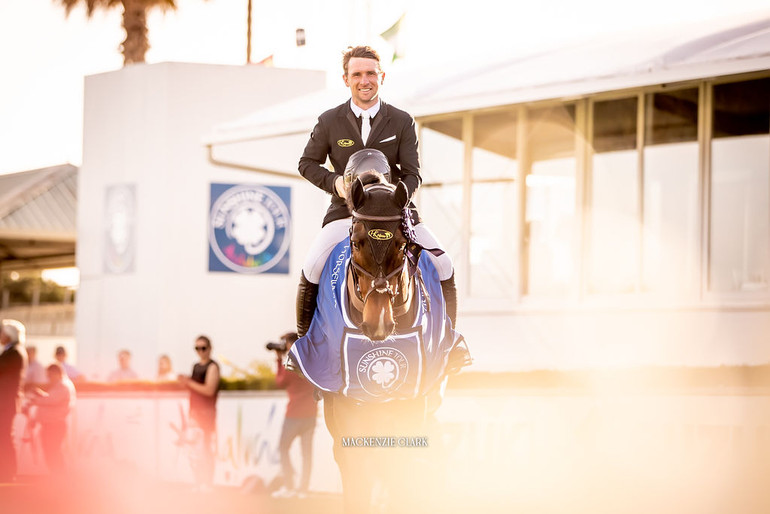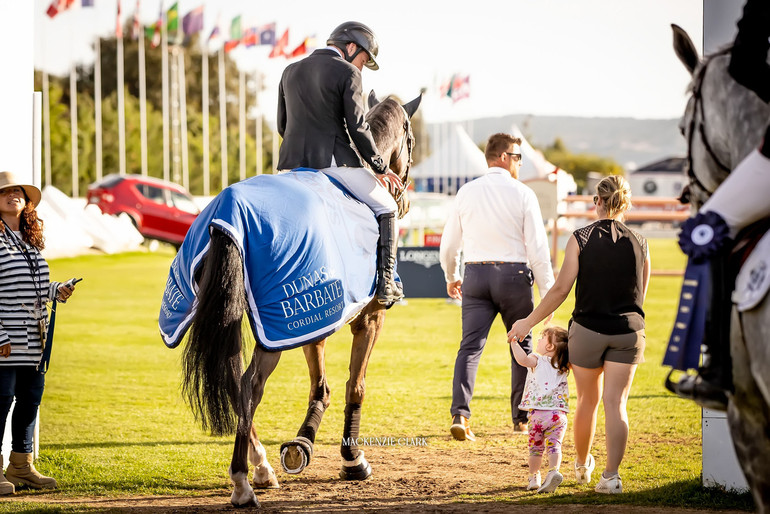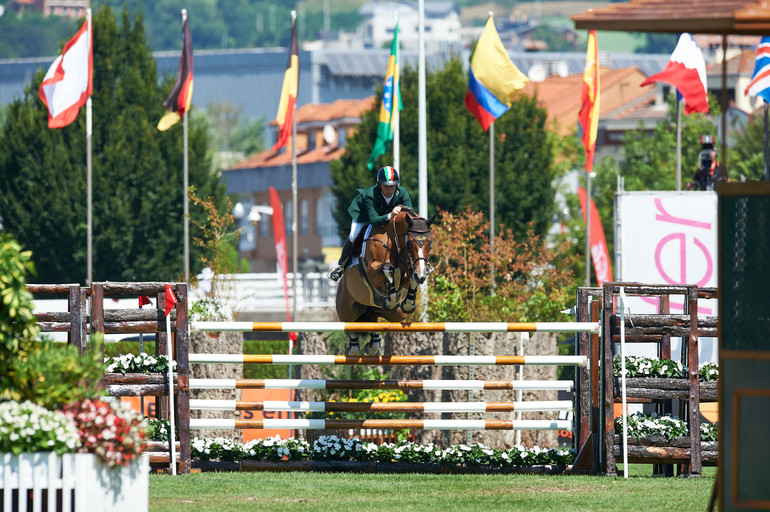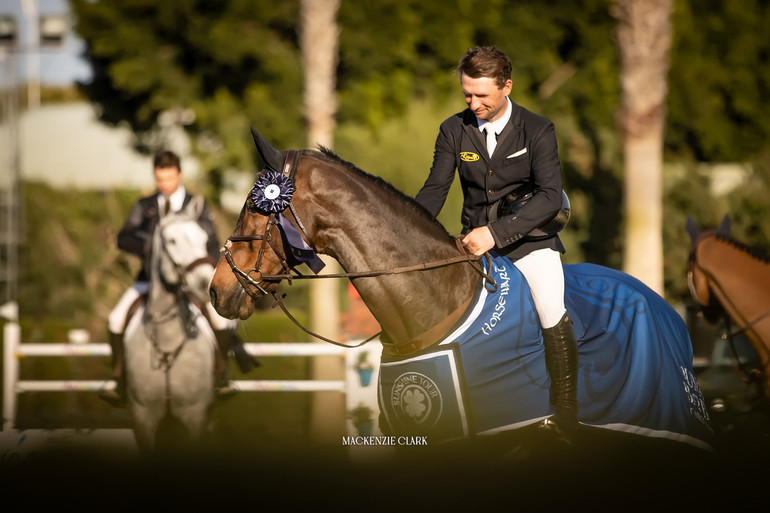 Ireland's Richard Howley has had an incredible start to 2023, recording six big wins within three weeks at the 2023-edition of the Andalucìa Sunshine Tour in Vejer de la Frontera, as well as taking the victory in the CSI3* Grand Prix in Oliva Nova in April, and this month finishing second in the CSI4* Grand Prix in Montefalco. Photo © Mackenzie Clark.
Ireland's Richard Howley has had an incredible start to 2023, recording six big wins within three weeks at the 2023-edition of the Andalucìa Sunshine Tour in Vejer de la Frontera, as well as taking the victory in the CSI3* Grand Prix in Oliva Nova in April, and this month finishing second in the CSI4* Grand Prix in Montefalco. Photo © Mackenzie Clark.
Text © World of Showjumping
After recording six big wins within three weeks at the 2023-edition of the Andalucìa Sunshine Tour in Vejer de la Frontera, as well as taking the victory in the CSI3* Grand Prix in Oliva Nova in April, and this month finishing second in the CSI4* Grand Prix in Montefalco, Ireland’s Richard Howley – currently no. 135 on the Longines Ranking – looks forward to an exciting season ahead with his two talented horses Consulent de Prelet Z (Consulent Z x Fuego du Prelet) and Messento (Messenger x Stakkatol).
“However, the problem with our sport is that getting into the bigger shows with the highest prize money is so difficult that it does not always make sense to keep these horses: There is not much good in having a horse with 1.60m quality if you can only get into a three-star show,” the 31-year-old tells World of Showjumping.
I think that the invitation system makes it very difficult to progress
“I got my first big win on an eventer, so I know it is all do-able, but it is hard," Howley continues. "There are so many people looking to buy these top quality horses, and when you are doing it on your own and you fund it yourself, it’s hard to keep them for the sport if you can’t get into the bigger shows. I am not against more money being in the game – I think it is good for the sport – but I do think that the invitation system makes it very difficult to progress. There should be more ranking points in the two- and three-star Grand Prix classes to allow riders that are consistent at this level to get enough points to climb up the ranking list and then gain access to the bigger shows."
Whilst getting into the bigger shows when being ranked outside the top 50 is very difficult, Howley has had his share of chances through the Irish team. “We all have to try and get in through the Nations Cups,” he explains. “I have been lucky enough to get a few shows a year; I won the five-star Grand Prix in Gijon in 2018, and was 2nd in the CSIO5* Grand Prix in St. Gallen in 2017 – both of these results were from getting into the shows through the team. As a rider, to keep the world-class horses, you need to be getting into these bigger shows.”
A family business
“We have about 150 horses at the moment, with a big breeding program that includes many good bloodlines. For the last ten years, we have tried to surround ourselves with very good mares, to try and produce and sell five-star Grand Prix horses,” Howley explains. “We have two fully functional stables right now, and about 50 horses in work. Not all of them will be superstars, but even the ones that aren’t fantastic jumpers get saddle broken and produced with the same care and then sold at a younger age. A lot of our horses are also bought in, or we own them in partnerships; it is very hard to say no to interesting offers that can come along the way. We like to produce our own horses, but without a sponsor and that stability, you can only continue with a few – you cannot continue with them all. Buying and selling horses pays for our sport.”
We have to work hard and make our own opportunities
“Trying to run it off our own backs as horse dealers is why we have so many horses; we try to keep the quality of the young horses coming through and I believe in the way we produce our horses. We have brought enough good horses through the ranks to say we can do this – it just takes time,” Howley points out.
And by “we” Howley refers to himself and his wife Morgan. Together, they run their business from Yorkshire, in the north of England. “I am extremely lucky to have Morgan,” Howley says. “She is amazing and a fantastic organizer and manager – that makes my life an awful lot easier. When I am away at the shows, I can really concentrate on the sport, I don’t have to worry about the running of the stable at home. However, it is not easy to do it all. Of course, it would be easier to have a big sponsor and six Grand Prix horses, but unfortunately for us, that is not how it goes. We have to work hard and make our own opportunities and our own horses.”
When the penny dropped
When Howley was 17, he moved to England and worked for Michael Whitaker for three years. “Then I broke my back and was out of action for several months,” he recalls of the time that changed the course of his life. “I only knew riding; and then I broke my back. When I was not able to do anything but sit on the side-lines and observe, I learned so much about horsemanship and the direction I wanted for my life and my business. I was forced to take that step back, I was on the outside looking in, and I figured out how I was going to approach riding on my return.”
I was forced to take that step back
“When I was not able to ride, the penny really dropped; I found my way during that time. When I got back to riding, I spoke with Michael. He is such an amazing, natural rider and a fantastic person to be around – especially at that time of my life. I wondered if it was maybe a good time to start on my own, with Morgan – and we took that step. Now, we are married and have a beautiful daughter, Winter, and a successful stable at HK Horses," Howley tells.
All about the balance
“I think no stable can stick to one program,” Howley says about his approach to producing young horses. “You need a system in your head, but every horse is different. If you are not flexible with that, you are potentially going to miss out on some horses that could be unbelievable; if you make them go in a way that isn’t right for that horse. It is all about meeting the horse in the middle; if your system does not suit the horse, you have to adapt yourself – not the other way around.”
“I think over-systemising the horses is not necessary; when you get them in to your way of going. We should never lose our horsemanship as riders. They also have to figure some of it out themselves,” Howley continues. “For me the most important thing with young horses is that the rider has to be balanced, very aware of the hands and the feeling. I really try and work on my own balance, and I am very strong on my riders so that they fully focus on their own body awareness when they are sitting on a horse – I think that is a very important part of riding. If you see a horse cantering down a field, it is not very often you see them miss a lead change, but when you put a rider on them that interferes, it stops the natural movement. I am not saying that we should be riding without tack or anything like that, but I do believe that the younger generation doesn’t work hard enough on the general discipline of riding. Riders are too fast to blame the horse rather than looking at their own weaknesses and asking themselves what can they do better.”
It is about the work you put in Monday to Friday at home
“Everyone has a different approach, but we keep it very simple and natural with our young horses and we don’t do so many shows with them,” Howley says. “Horses have to be produced with care and a bigger picture in mind. You should not be running from show to show every week, looking at your results asking why you are not jumping clear.”
“As a rider, you have to stay grounded,” Howley points out. “You can never stop working on yourself and training to be better. The most important thing for me is the idea that riding fast and winning classes is not about cantering fast at jumps – you don’t win a Grand Prix with luck. It is about the work you put in Monday to Friday at home on the flat, your balance, your control, your plan, building up to the class and then finally executing your round. I believe success is not down to having luck on the day but rather about how much work you put in.”
Aiming for that green jacket
With Consulent de Prelet Z and Messento, Howley is now looking forward to an exciting season – he believes that there aren’t too many tracks in the world these two horses couldn’t jump. “Consulent is my best horse at the moment, he has won a few Grand Prix classes already,” Howley tells. “I hope to get into a few five-star shows this year with him so that I can compete at the highest level. I believe he is good enough to hold his own in any field. Messento is a very good horse as well, he is owned by myself and our two good friends – Sarah Borthwick and Oisin Murphy. We bought him as a seven-year-old in France and he is now turning out to be a really good Grand Prix horse, taking it all in his stride. Oisin came to me two years ago and said he wanted to buy a share in a horse that I think can jump the Aga Khan – and that is why we bought Messento as a seven year old. My team and I are invested into that idea. When someone wants to get behind you with a goal like that, it fuels the fire for me to really try and make it happen. I don’t think it is unachievable – as long as our Chef d’Equipe Michael Blake likes the horse, and we fit in the team at the right time, it is doable.”
To be able to put the green jacket on, I think it means more to any Irish rider than any individual Grand Prix
“I would love to be on an Aga Khan-winning team one day,” Howley continues to speak about his goals. “I would love to go to a championship in the next few years, and in general I aim to do the Nations Cups. I love to compete for Team Ireland – to be able to put the green jacket on, I think it means more to any Irish rider than any individual Grand Prix. The Irish people in general are very passionate and they really get behind their country and all of us like to ride and fight together. Sometimes, we have to fight each other to get on the team, but when we are all lined up together, on the day of the Nations Cup, everyone is going to have their hand on the next man’s back to try and get the job done and get the win assured. Michael Blake is a very motivated Chef d'Equipe, it’s a good energy to be around. We all want to be on the team, but only four can line up at a time.”
Horsemanship should never be lost
When it comes to the future of the sport, Howley has his concerns. “I think people have gone away from producing horses to only seeing how high they can jump over a fence. It seems that everyone wants to ride either a fancy young horse or a horse jumping above 1.40m,” Howley points out. “I think that if the sport continues to develop in this direction, there is going to be an even more serious divide in the sport. It's very hard to get good enough riders with enough patience to produce the horses. Already now, there are nearly too many clients for the number of horses that are getting produced right, which in turn means the good horses are getting more expensive."
“We should not forget that every single Grand Prix horse that there has ever been throughout the ages has been produced from start to finish – and it takes eight years to get a horse from a foal to jumping 1.40m classes. The horsemanship that requires, and the time, has to be preserved for the future,” Howley says. “If horses stop getting produced correctly with the right professionals, then there will be a shortage of horses for the highest level. Some of us have to have the big numbers and the added stress, to try and get our hands on those better horses – which are so valuable these days, and so hard to find ready-made.”
25.5.2023 No reproduction of any of the content in this article will be accepted without a written permission, all rights reserved © World of Showjumping.com. If copyright violations occur, a penalty fee will apply.













